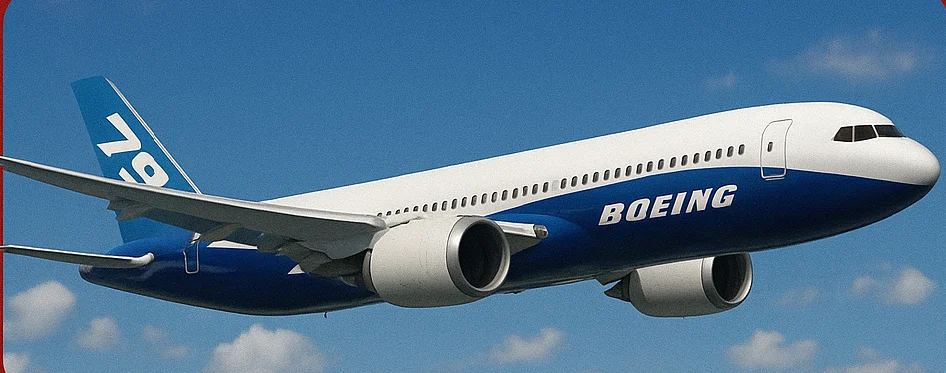What Is the Boeing 797 / NMA?
- The Boeing New Midsize Aircraft (NMA), often referred to by enthusiasts and analysts as the “797”, has been talked about for nearly a decade.
- It is envisioned to fill the “middle of the market” — larger and longer-range than single-aisle jets like the 737 MAX or A320neo, but smaller, more efficient, and less expensive than widebodies such as the 787.
- Intended capacity is expected to be approximately 220-270 passengers, range in the ballpark of 4,500-5,000 nautical miles. Twin-aisle configuration is being discussed to improve boarding times and passenger comfort. Cargo space trade-offs are part of early design discussions.
Table of Contents
Recent Developments: What’s Changed
These are the newest, most credible signals that the 797 is moving from concept toward possible reality:
- Public Acknowledgment of Design Studies
In 2025, Boeing’s general manager for airplane developments, Mike Delaney, confirmed that design, production, and cost characteristics are aligning well enough to make the NMA more than just internal conversation. He emphasized that the proposed aircraft will have a composite fuselage and a “hybrid cross-section.” - Manufacturing Location Commitments
Boeing has committed (via labor contracts and public statements) to build its “next new airplane” in Washington state, reinforcing that facilities in the Puget Sound / Pacific Northwest will be central to the 797’s production. - Hybrid Design & Composite Materials
Confirmed use of composite materials and a “hybrid cross-section” design is relatively new. These indicate Boeing is thinking beyond simply stretching existing designs, and instead aiming for new structures to improve weight, fuel efficiency, and maintenance.
Airlines are increasingly reliant on the Airbus A321XLR to serve medium-haul and transcontinental routes. Boeing has been pressured to respond. In parallel, analysts estimate there may be demand for 3,500-4,000 aircraft in this mid-market segment over the next 20 years.

What’s Still Murky / Unconfirmed
While momentum appears to be increasing, many critical pieces are still unconfirmed:
- Official Launch Date: Boeing has not yet formally launched the 797. There’s still no public timeline with firm entry-into-service (EIS) date, though industry estimates tend to place that in early 2030s.
- Engine Supplier(s): No confirmed vendor. Possible candidates may include innovations from GE/Safran (e.g., RISE program), Rolls-Royce (though past engine issues and trust may complicate things), or scaled existing engine designs. But nothing is locked in.
- Final Design Specs: Layout (seat count, cabin width, aisle configuration), fuselage length, cargo volume, and trade-offs between range vs payload are still under study. Some reports suggest a twin-aisle “hybrid cross section” but exact numbers are speculative.
- Regulatory, Cost, and Risk Constraints: Boeing is still recovering from the 737 MAX crisis, delays in 787, issues with 777X, and increased FAA/regulatory scrutiny. These add risk and could delay or inflate the program. Investor caution is high.
Why It Matters
- Market Gap: There’s strong demand from airlines for a “sweet-spot” aircraft that combines enough range with moderate capacity and operating cost. The legacy 757/767 retiring, A321XLR filling some routes, but with limitations — cargo, comfort, boarding times, etc.
- Competition with Airbus: Airbus currently has the upper hand in narrowbody and midmarket. If Boeing delays too long (or fails to deliver), it risks permanently ceding this segment. A321 family backlog is strong; upcoming next-generation Airbus plans could further tighten Boeing’s window.
- Brand, Investor, and Regulatory Pressure: Boeing’s reputation has been damaged over quality, safety, and delivery delays. Success with the 797 could help restore credibility. But missteps will penalize the company heavily. Regulatory requirements (especially post-MAX) are stricter, which increases both time and cost to certify.
Will Boeing Actually Build It This Time?
Given the combination of rising demand, evolving technology, competitive pressure, and internal signals, there is a reasonable chance that Boeing will formally commit to the 797. However, “reasonable” does not mean guaranteed. Key factors that will influence whether the 797 becomes real:
- Executive Decision & Budget Allocation: The leadership must officially green-light the program, commit sufficient R&D and capital, and accept the risk.
- Launch Customers & Orders: Early customers (airlines or leasing companies) need to commit contracts. This secures cash flow and encourages Boeing to move from study to production.
- Engine & Supplier Partnerships: Securing reliable engine technology timely is essential. The RISE program and other next-gen engine tech will be critical. Also, supplier infrastructure must be prepared.
- Meeting Safety/Regulatory Standards: FAA and international regulators will hold Boeing to high standards. Certification must be rigorous yet efficient.
- Cost Control & Avoiding Past Pitfalls: Delays, quality problems, cost overruns have hurt Boeing’s past projects (787, 777X, the troubles of 737 MAX). Learning lessons and managing scale and complexity will be decisive.
Timeline: What to Watch For
Here are upcoming milestones and signals that could indicate whether Boeing is serious:
| Timeframe | What to Watch |
|---|---|
| Late 2025 – Early 2026 | Decision on design freeze, clear public announcement, possible launch customer(s). |
| 2026-2027 | Engine partner(s) confirmed, prototype or mock-ups, investment in composite production & tooling. |
| Early 2030s | Entry into service (if everything stays on schedule), with initial revenue routes. |
The Boeing 797 (or New Midsize Aircraft) has hovered on the edge of possibility for years. Recent public comments, design studies, manufacturing commitments, and airline interest all suggest Boeing may at last be ready to move forward. But the technical, regulatory and financial risks remain high. If Boeing succeeds, the 797 could restore its hold on the mid-market segment and help the company reclaim lost ground. If it fails again, Boeing risks confirming that this gap is no longer theirs to fill.
Join us on Telegram Group , Instagram for the Latest Aviation Updates.
Also read:Boeing 797: Everything We Know About Boeing’s New Mid-Market Jet – AeroTexts

